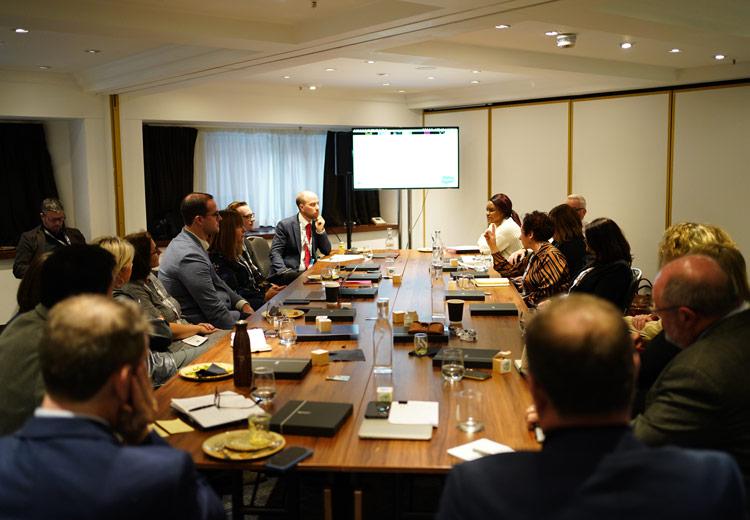
From the lab to life: how to demonstrate research excellence

You may also like
Communicating the myriad ways that universities’ research benefits and changes society has never been more important. But what are the most compelling means to convey original knowledge and discoveries from labs, libraries and the field to policymakers, industry, fellow academics and the general public? All researchers, from STEM to the humanities, need the skills to amplify their findings, whether through traditional academic routes such as publication in specialist journals and conference presentations; via engagement with news outlets or social media; or by informing government policy and commercialising discoveries. This collection offers insight and advice on different ways to showcase research so it makes a difference.
Amplifying research beyond academia
For academics to generate interest in their work and see their discoveries and insights applied in real world contexts – from new products to socio-political insights – they must learn to communicate and promote their work outside academic circles. This requires very different skills and approaches, distilling complex work into key, relevant messages. Here, academics explain how they’ve done it.
Why is no one listening? Academic ways of communicating are often the exact opposite of what you need to draw widespread attention to your research, writes Simon Hall of the University of Cambridge. Here are simple ways to help your message reach its audience.
The perils of unheard policy: Effective communication is a core component of successful policymaking. Whether you’re a policy professional or working in communications, how you convey your message can determine whether your ideas thrive or fade, writes Alistair Sackley of the University of Southampton.
How to communicate your research to anyone: Presenting research to a non-academic audience requires a different set of skills compared with speaking to your peers. Follow these techniques from Mats Vermeeren of Loughborough University to get your point across to the layman.
Get your research out there - 7 strategies for high-impact science communication: From news angles to dealing with trolls, Christina Zdenek of the University of Queensland outlines seven areas to consider when sharing your findings with the media and wider public.
Get the word out - four ways to communicate with non-academic audiences: Sharing scientific research with the wider public can be instrumental in breaking down the barriers to academic work. Arden University’s Ashleigh Johnstone offers advice.
Campus webinar - how to present research to a wider audience for greater impact: Learn about ways to articulate and present your work to non-academic audiences from experts from University of Alberta, Virginia Tech, University of Southampton and Chapman University.
The language of impact
Impact is a broad term, meaning different things for different people. For individual academics, it may mean informing a particular funding body or interest group about a specific topic. But for an institution it may encompass the full spectrum of value they bring to society, through research, teaching, outreach and more. Both require effective ways to measure and convey outcomes for audiences with influence but not necessarily an in-depth understanding of your field. Starting with a breakdown of the key terms, these resources look at how to align expectations between different parties and what is at stake.
Demystifying impact - a glossary of key terms: The extensive terminology surrounding research ‘impact’ can be confusing for those new to it. To help, Alex Smith and Laura Tucker of Vertigo Ventures have compiled a glossary of the most common terms.
Donors want to see real-world impact. What does that mean for higher education in the sciences? Amid academia’s challenges related to talent retention and fundraising, universities can use translational research programmes to enhance scientific edge and real-world impact, and strengthen donor relations, Shai Shen-Orr of Technion – Israel Institute of Technology explains.
Defining impact - a shift in thinking, acting and being: What is impact? And, more importantly, how do universities foster and measure it? Here is a plan to raise impact awareness, literacy and readiness, from a team from the European university network, Enlight, and Euskampus Fundazioa.
Show your research impact - a guide for academics and researchers: In academia, effectively demonstrating and communicating the real-world impact of research is increasingly vital for scholars, driven by demands from funding bodies and academic institutions, writes Mohammed Al-Bahrani of Al-Mustaqbal University.
How to add value to research and manage intellectual property: Ensuring new knowledge has social, environmental or economic impact is an essential element of research – and of universities’ purpose. Here, the University of Luxembourg's Christophe Haunold explains the four steps to consider.
Who should care about your research?
Before you plan your public engagement strategies, you need to consider who you wish to reach and what form of communication will work for you. Here, experts in impact shares insights on how academics can start to understand the wider implications of their work and thus, who should be informed and when.
How to make public engagement work for early career academics: Academics need to be able to translate what they research to engage a wide range of audiences. But to do that, scientists must first find the public engagement shape that fits them and their schedule. Here’s advice for getting started, from colleagues at the University of Southampton, the University of Western Australia and Plymouth Marine Laboratory.
So what? Who cares? The skill of talking about impact: The University of Edinburgh’s Darcey Gillie explains the importance of talking about impact in higher education and offers practical steps on how to do it.
Questions to foster open and engaging research communication: Each stage of a research project comes with questions about what information to share and with whom. Richard Holliman of the Open University offers practical advice on how to make your research communication more transparent and engaging.
Key questions to help universities measure societal impact: When societal impact has so many definitions, how can higher education institutions measure it without overlap or disengagement? This coordinated approach presented by a team from Maynooth University aims to find accepted, effective common ground.
From peanut butter to effective policy impact: In a sector that often seems tasked with being everything to everyone, each university needs a policy strategy that focuses institutional expertise where it will make the most difference, writes Alistair Sackley of the University of Southampton.
Pointers for successful policy engagement
Academics who wish to work with government officials and policymakers must learn to navigate the halls of power and speak in the language of politics. These resources offer insights from researchers in UK and US.
What I learned about knowledge transfer with policymakers during my parliamentary fellowship: Advice on how to share your research with the aim of maximising knowledge transfer among policymakers in parliament, from Rajiv Prabhakar of the Open University.
Writing and presenting reports for government - five dos and five don’ts: A guide for academics on the dos and don’ts of writing and presenting research reports designed to inform policymakers, by Naresh Pandit of the University of East Anglia.
Five steps for engaging policymakers with research: Five pointers to help researchers get policymakers interested in their work, based on a guide co-created by government and academics from the University of Leeds, outlined here by Ben Walmsley.
Learning the craft of using your research to engage in policy: David Garcia of Arizona State University explains how academics can get their research noticed by politicians in order to inform and impact policy decisions.
How institutions can help academics demonstrate the value of their work
You don’t have to go it alone in your quest for impact – help is available. Lean on your institution for support in generating interest in you work. The comms team is the obvious source of assistance but academics can also consult policy experts, impact officers, knowledge transfer teams and public engagement and outreach teams, to name a few.
The university support services that help demonstrate research impact: Library and knowledge transfer services are just two of the institutional resources available to help academics show the impact of their research. Find out which tools to use and when from Tugce Ataci of Université Paris-Est Créteil.
We set up a thought leadership programme to amplify PhD research: Dalhousie's OpenThink programme shows how universities can empower the next generation of thought leaders and facilitate public engagement, as Lynne M. Robinson explains.
A campaign to communicate the impact of university research: With public perception of US higher education in decline, universities urgently need to send an engaging, integrated message about how their work benefits society, writes Paul M. Rand of the University of Chicago. Here’s how his institution is doing it.
A bridge between academics and communications staff: Science communication in a post-Covid world calls for a new way to span the gap between researchers and university comms teams – and a new skill set, as Michael Head of the University of Southampton explains.
How universities can help rebuild trust in science: The crisis of confidence in science has deep origins. The answer to regaining traction is compelling stories and the skills to tell them beyond the academy, writes Bartłomiej Knosala of the Silesian University of Technology.
Unwrapping discovery - the importance of institutional repositories: Self-archiving in university repositories is an alternative academic publishing route to gold open access that can boost citations and diversify users accessing scholarly content, writes the University of Southampton’s Nicki Clarkson.
Effective use of academic publishing
Academic publishing is often the first step to impact. But the publication of a journal article or book alone will not necessarily generate the impact that a researcher is seeking. This requires active promotion alongside publication, as these experts explain.
Seven steps to dual publication: The dual publication model for research involves creating two versions of a research paper: one for fellow academics, and one for practitioners. Juggle the two with these seven steps shared by Şerife Eyüpoğlu of Near East University.
Scholarly publishers’ role in fostering collaboration in academia: With the infrastructure in place to exchange ideas and information, journals can enable scholars to build on their research and accelerate discovery and quality of innovation, as Antonia Pop from the University of Toronto Press explains.
Life after publication - promote your work for maximum impact: Seeing your work in print is by no means the end of the story. Elsevier’s Chris Tancock offers advice on how you can make your published work stand out and benefit from the broadest visibility.
Make conferences work for you
The academic conference circuit is a well-trodden path for researchers keen to broadcast their work and build their profiles across global higher education. From preparation and practice to overcoming anxiety, these resources offer advice to turn a nervous novice into a presentation pro.
A practical guide to better public speaking, part one: Getting through long, not-so-interesting talks is a common experience in academia. But if we all agree it can be done better, how can we start delivering better presentations? Anna Christodoulou of the University of Westminster looks for answers.
Conference presentations 101 - master the art of speaking to an audience: Don’t get stage fright when it comes to presenting your research. Ayten Ordu of Near East University offers her tips for preparing for speaking success.
Creative new ways of talking about research
With the potential to reach a global audience of listeners, podcasts offer a fun and engaging way to share research activity. Setting one up is easier than you might think. Or brave scientists could even try their hand at humour. Here’s how to choose the right platform – and equipment – and find your niche.
Five things to know before you launch a research podcast: Starting a podcast can open up your research to a new audience. David Allan and Andrew Murray of the University of the West of Scotland show how.
Academics can (and should) be idiots: The comedy stage can be a place for academics to be silly and let it all hang out. Chris Pahlow of Amplifying Research explores why humour is effective for scholars and the people they’re trying to communicate with about their research.
The making of - turning a research project into a documentary: To get your research findings into as many hands as possible, consider filming a documentary. James Layton, Paul Tucker and Bettina Talbot, from the University of the West of Scotland, offer their advice.
Using documentary film to communicate your social research: Film can humanise your research and make it accessible to an audience beyond your field. Rosalind Edwards of the University of Southampton shares five key takeaways on bringing sociology to life.
Academic media relations guides
Newspapers, broadcasters and other consumer media provide a powerful outlet to share academic research or expertise with a mass audience. But they work in ways that may feel alien to an academic trained in writing for specialist journals. Journalists want strong news hooks to inform short, snappy pieces of content on tight deadlines. These resources offer advice on engaging with and writing for mass media.
How to engage with the media and expand the impact of your work: Academic scholars are generally not trained to write for broad audiences, so how do you get your compelling, newsworthy research out there? Chapman University’s Gregory R. Goldsmith offers five considerations.
Tips for sharing your research and professional expertise with consumer media: Academics can offer insight based on research and professional experience that is applicable far beyond the scope of academic journals. Samuel Kim Kwong Kwok of Xi’an Jiaotong-Liverpool University shares a guide to engaging with the mainstream consumer media.
You’re a content producer now, part two - how to craft an article for mainstream media outlets: After you’ve decided your topic and format, it’s time to consider the details of writing the story, says John Weldon of Victoria University – from mastering tone, style and point of view to all-important SEO.
It’s a numbers game
While research is about far more than numbers, when it comes to demonstrating impact they can be helpful. Publishing work through open access channels can broaden its reach, enabling anyone to freely use, share and build upon your data – even when it may not lend itself to numbers. This brief guide explains the process. Once work is published, understanding audience and citation metrics can help you boost the visibility of your work. Find out how here.
Making research metrics work for you, part two: Steps you can take to improve your research data and elevate the visibility of your work, in part two of Ioannis Glinavos of the University of Westminster’s advice on managing metrics.
Opening doors to knowledge: making data open access: Making data open access has become a cornerstone of transparent and collaborative research practices. Here, Jon Petters of Virginia Tech provides a brief guide on how to do it, emphasising accessibility, reproducibility and interoperability.
Sharing qualitative research through open access: Traditional open access repositories are designed for sharing quantitative data. But what about qualitative data – non-numeric information and concepts such as case studies or interview transcripts? That’s where the Qualitative Data Repository comes in, Nathaniel D. Porter of Virginia Tech explains.
How to develop a graphical framework to chart your research: Graphic representations or frameworks can be powerful tools to explain research processes and outcomes. David Waller of the University of Technology Sydney explains how researchers can develop effective visual models to chart their work.
Thank you to all who contributed their expertise and insight to this guide.
If you would like advice and insight from academics and university staff delivered direct to your inbox each week, sign up for the Campus newsletter.


